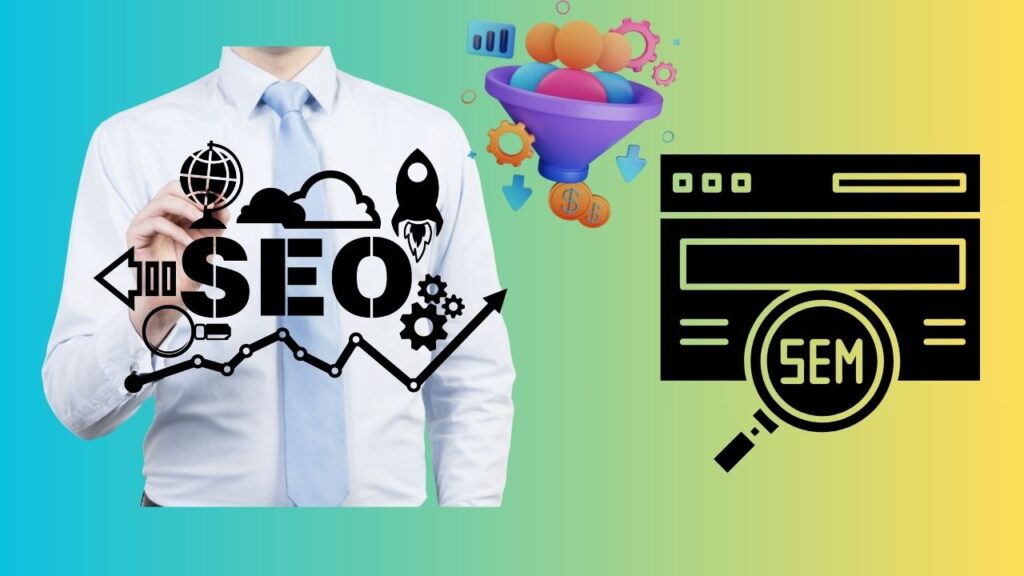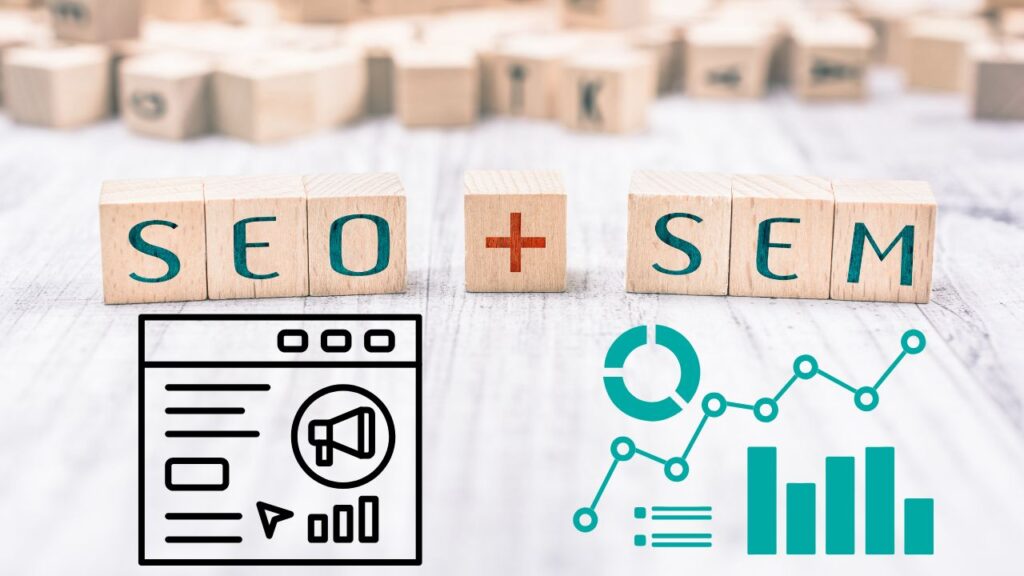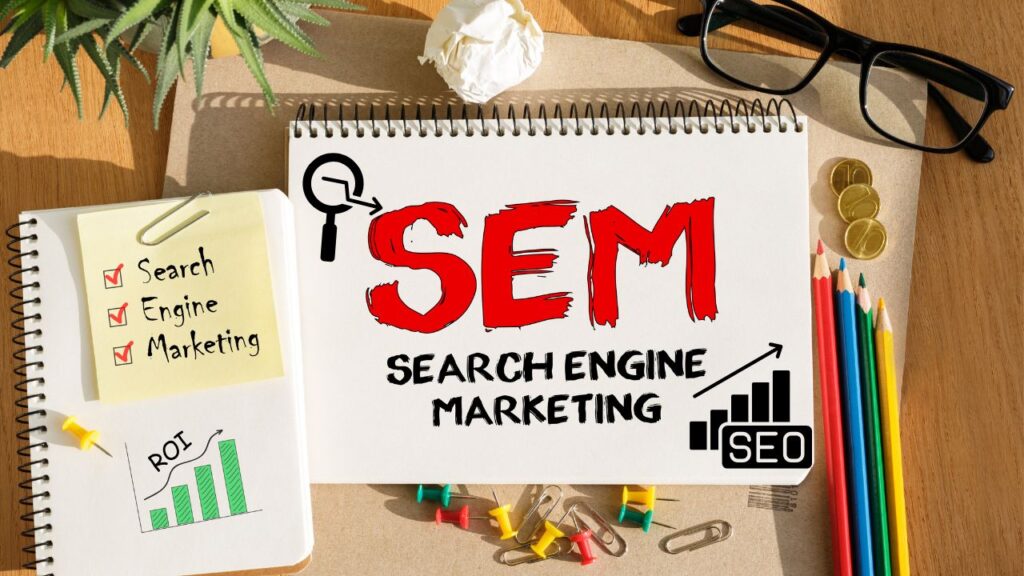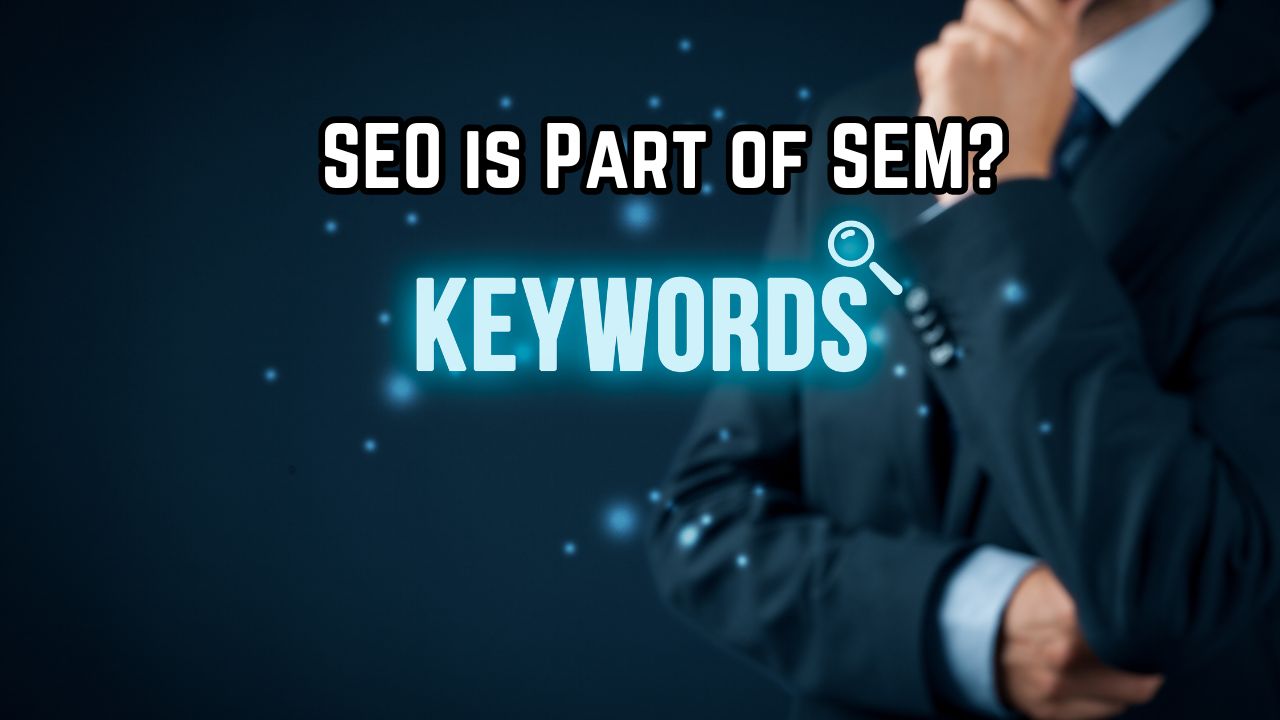Understanding the Relationship: Is SEO Part of SEM?
Many people often wonder about the link between SEO and SEM. Understanding this relationship is important for anyone looking to enhance their online visibility. Search Engine Optimization (SEO) and Search Engine Marketing (SEM) both play crucial roles in digital marketing, but they serve different purposes.
Is SEO Part of SEM? SEO focuses on optimizing your website content to achieve higher rankings in organic search results. It is all about making your site more attractive to search engines, thereby improving your visibility without paying for ads. On the other hand, SEM encompasses a broader range of strategies, including paid advertising. SEM includes SEO but also integrates other techniques to enhance your online presence, such as pay-per-click (PPC) advertising.
To dive deeper into the relationship, let’s look at how these two concepts relate to each other:
- Common Goal: Both SEO and SEM aim to increase website traffic. However, their methods differ.
- SEO as a Component: SEO is often considered a integral part of SEM, as it focuses on organic search results.
- PPC Inclusion: SEM includes paid strategies like PPC, which can drive immediate traffic.

One of the significant distinctions between SEO and SEM lies in the time investment required. SEO is a long-term strategy that relies on quality content, reliable backlinks, and proper keyword usage. It may take months to see significant results from SEO efforts. However, SEM tactics can produce quick results in traffic when implementing paid ads effectively.
Moreover, your SEO tactics can enhance your SEM efforts.
How SEO Supports SEM
Here are some ways SEO benefits SEM:
- Keyword Research: The keywords you identify for your SEO strategy can be used for SEM campaigns. This ensures you are targeting the right audience.
- Quality Score Improvement: Google gives you a Quality Score that impacts the cost and effectiveness of your ads. Quality Scores are higher when your site is SEO optimized.
- Enhanced Landing Pages: SEO encourages you to create valuable content leading to better landing pages. This can boost your conversion rates in SEM campaigns.
SEO and SEM Strategies
When developing your marketing strategies, consider incorporating both SEO and SEM techniques. Below is a brief overview of strategies to apply:
| SEO Strategies | SEM Strategies |
|---|---|
| Content marketing to provide value. | PPC campaigns targeting specific keywords. |
| Using meta tags effectively for organic search. | Creating compelling ad copy for higher click-through rates. |
| Building quality backlinks. | A/B testing of landing pages to improve conversions. |
Is SEO Part of SEM, Understanding the relationship between SEO and SEM allows you to create a more cohesive digital marketing strategy. By merging both approaches, you can maximize visibility and effectiveness.
Investing time and resources into optimizing both SEO and SEM can lead to sustainable online growth. Although they differ in execution, using both can complement each other effectively, leading to improved performance in search rankings and, ultimately, in conversions.
Furthermore, effective tracking and analytics will help you measure the success of both strategies. By analyzing which keywords and landing pages perform best, you can refine your tactics over time and achieve better results.
Integrating SEO within your SEM strategy is key to maximizing your site’s visibility and traffic potential. As you execute your digital marketing initiatives, understanding how SEO and SEM interact will empower you to make informed decisions that benefit your online presence.
Key Differences Between SEO and SEM
Is SEO Part of SEM? Understanding the difference between SEO and SEM is crucial for anyone looking to succeed in online marketing. Both strategies play essential roles in driving traffic but differ significantly in approach, cost, and execution. This article delves into these different facets, helping you grasp how to optimize your online presence effectively.
To begin, let’s clear up some terms. SEO, or Search Engine Optimization, refers to the process of enhancing your website to improve its organic visibility in search engine results. On the other hand, SEM, which stands for Search Engine Marketing, encompasses a broader range of marketing techniques, including both paid search ads and organic search strategies. Here are the key differences to consider:
Cost Structure
One of the most noticeable differences is how costs are incurred:
- SEO: Generally, SEO is considered a long-term investment. It involves costs associated with on-page and off-page optimization, content creation, and possibly hiring SEO specialists. While these costs can be substantial, they do not directly translate to immediate expenses like paid ads.
- SEM: SEM typically requires ongoing financial investment in the form of pay-per-click (PPC) advertising. Each click on your ad results in a charge. Therefore, depending on your budget and bidding strategies, SEM can become quite costly.
Time Investment
The timeframe to see results varies between the two strategies:
- SEO: Improvements can take weeks or months to manifest. Factors like competition, keyword strategy, and search algorithms all play a part in how quickly your site climbs search rankings.
- SEM: You can see immediate traffic from SEM. Once your ad is live, it can start driving visitors to your site almost instantaneously, making it a quick way to generate leads.
Traffic Quality
The quality of traffic generated through SEO and SEM can differ:
- SEO: Organic traffic gained through SEO tends to be more engaged. Users clicking on non-paid listings often find your content through valuable search queries, which typically means they have a genuine interest in what you offer.
- SEM: While SEM can drive immediate clicks, not all paid traffic leads to high-quality engagement. Users may click on ads out of curiosity or misunderstanding, leading to a higher bounce rate.
Targeting Options
Both approaches allow for audience targeting but through different methods:
- SEO: Keyword optimization focuses on bringing in visitors based on relevant search queries. The targeting is tied to where your site ranks for specific keywords.
- SEM: You have more sophisticated targeting options. Platforms like Google Ads enable geographic targeting, device targeting, and even demographic filters, helping you to reach your ideal audience more effectively.
Long-term vs Short-term Strategy
The strategic element sets these two approaches apart:
- SEO: Prioritizes long-term sustainability. Once you achieve strong rankings, it often requires less ongoing work to maintain visibility.
- SEM: Is typically viewed as a short-term strategy. When you stop paying for ads, the traffic stops almost immediately.
Implementation
Another difference lies in how each strategy is executed:
- SEO: Requires consistent effort in optimizing website content, acquiring backlinks, and enhancing user experience.
- SEM: Involves creating targeted ads, managing bids, and continuous monitoring of ad performance to refine and improve results.
| Aspect | SEO | SEM |
|---|---|---|
| Cost | Long-term investment | Pay-per-click (PPC) model |
| Time to See Results | Weeks to months | Immediate |
| Traffic Quality | Higher engagement from organic searches | Variable engagement, potentially higher bounce rate |
| Targeting | Keyword-based targeting | Advanced audience targeting |
| Strategy Type | Long-term strategy | Short-term strategy |
Ultimately, the choice between SEO and SEM depends on your goals, budget, and time frame. Understanding these key differences enables you to devise a strategy that aligns with your business needs. You can even use both strategies in tandem for a holistic approach to online marketing. Balancing the long-term benefits of SEO with the immediate results of SEM can maximize your online presence effectively.
The Importance of Integrating SEO and SEM Strategies
Is SEO Part of SEM? When navigating the digital marketing landscape, the terms SEO (Search Engine Optimization) and SEM (Search Engine Marketing) often come up. Understanding how these two strategies relate to one another can significantly impact your online success. In fact, integrating SEO and SEM can lead to enhanced visibility, more effective campaigns, and better overall performance. Let’s explore why this blend is crucial for marketers.
SEO is the process of optimizing your website for organic search with the goal of improving your ranking on search engine results pages (SERPs). This involves various techniques such as keyword research, content creation, link building, and technical optimization. Conversely, SEM covers paid advertising strategies, primarily pay-per-click (PPC) campaigns like Google Ads. While these methods differ, they share a common objective: to generate traffic and leads.
Benefits of Integrating SEO with SEM
Combining SEO and SEM strategies offers several advantages:
- Increased Visibility: Using both strategies amplifies your presence on search engines. While SEO targets organic rankings, SEM captures users searching for immediate solutions.
- Data-Driven Insights: Insights from SEM campaigns, such as the performance of specific keywords, can inform your SEO efforts. If certain keywords perform well in your ads, consider optimizing your content for those same keywords.
- Understanding User Intent: SEM allows you to analyze which ads gain clicks and conversions, indicating user intent. This can guide your SEO content strategy.
- Cost-Effectiveness: Combining strategies can lead to reduced costs. Improved organic traffic results from your PPC campaigns can lead to a decrease in your overall paid ad spend.
Working Together for Maximum Impact
To maximize the impact of both SEO and SEM, follow these strategies:
- Keyword Synergy: Conduct thorough keyword research for both SEO and SEM. Find overlapping keywords that yield the best results. Focus on high-volume keywords for SEM, while also optimizing for long-tail keywords organically.
- Landing Page Optimization: Design landing pages that perform well for both paid and organic traffic. Use strong calls to action (CTAs) and ensure the page content is relevant to the keywords you are targeting.
- A/B Testing: Use A/B testing in both SEO landing pages and SEM ads. Understanding what works best will help refine both campaigns and provide richer data.
- Consistent Messaging: Ensure that the messages in your ads align with the content on your landing pages. Consistency fosters trust and encourages conversions.
Measuring Success
To determine the success of your integrated strategy, monitor key metrics:
| Metric | Description |
|---|---|
| Click-Through Rate (CTR) | Measures how often people click your ads or organic listings compared to how often they are shown. |
| Conversion Rate | Tracks the percentage of visitors who complete a desired action, such as filling out a form or making a purchase. |
| Cost Per Acquisition (CPA) | Calculates the cost to acquire each customer through SEM, helping assess ROI. |
| Organic Traffic Growth | Monitors changes in organic traffic to measure SEO performance. |
By analyzing these metrics, you can make informed decisions to boost your marketing strategies and optimize your budget effectively.
The Future of Digital Marketing
Is SEO Part of SEM? As digital marketing continues to evolve, the integration of SEO and SEM will play an increasingly vital role. The lines between organic and paid search are blurring, making it essential for marketers to adopt a holistic approach. Embrace the synergy between these strategies now to stay ahead of the competition and drive sustained growth.
The combination of SEO and SEM isn’t just beneficial; it’s essential for achieving your digital marketing goals. By understanding the relationship between these two disciplines, you can create a more effective online presence, attract a broader audience, and ultimately achieve better results for your business.
How SEO Enhances SEM Campaigns
When you think about online marketing, you might first consider SEM, which stands for Search Engine Marketing. SEM primarily focuses on paid search ads to drive traffic to your website. However, you might not realize how SEO, or Search Engine Optimization, plays a crucial role in boosting your SEM campaigns. Understanding how these two strategies interact can help you achieve better results in your marketing efforts.
Understanding the Relationship Between SEO and SEM
The key to appreciating how SEO enhances SEM lies in understanding what each strategy involves. SEM mainly deals with purchasing ads to appear at the top of search engine results. Conversely, SEO revolves around optimizing your site’s content for organic rankings. Although they are distinct approaches, using them together can elevate your online presence.
The Cost Effectiveness of SEO
Investing in SEO can lower your overall marketing costs in the long run. With effective SEO practices, you can improve your organic search rankings, which reduces reliance on paid ads. Here are some ways SEO contributes cost-effectively:
- By improving organic traffic, you spend less on PPC (Pay-Per-Click) campaigns.
- Better SEO increases your Quality Score on Google Ads, potentially lowering your CPC (Cost-Per-Click).
- A well-optimized website results in higher Conversion Rates (CR), making each ad dollar go further.
Improved Ad Relevance
Is SEO Part of SEM, SEO helps enhance the relevancy of your ads. With targeted keywords optimized for organic search, you can utilize the same terms for your paid campaigns. This means your ads will appeal more to users who are already interested in those topics. Higher ad relevance leads to:
- Increased Click-Through Rates (CTR).
- Better landing page experiences, leading to higher conversion rates.
- Improved Quality Score, which ultimately lowers your costs in SEM.
Keyword Research Synergy
Effective keyword research serves as a cornerstone for both SEO and SEM. By understanding what potential customers are searching for, you can target the right audience. Here’s how this synergy works:
| Element | SEO | SEM |
|---|---|---|
| Keyword Targeting | Focuses on long-tail keywords for content. | Utilizes high-traffic keywords for ads. |
| Search Intent | Addresses user needs organically. | Targets specific conversion goals. |
| Performance Metrics | Measuring engagement and rank positions. | Analyzing CTR, CPC, and ROI. |
Enhancing User Experience
Good SEO improves your website’s usability. A user-friendly site encourages visitors to stay longer and engage with your content. This enhanced experience matters for both organic and paid traffic. Here’s how:
- Optimized layout and navigation helps in guiding visitors.
- Responsive design ensures accessibility across devices, enhancing user experience.
- Fast loading times decrease bounce rates, increasing the likelihood of conversions.
Leveraging Analytics for Continuous Improvement
Combining SEO with SEM gives you greater insight into your audience. Utilizing analytics allows you to adapt your strategies based on real data. Consider these points:
- Track the performance of both organic and paid traffic to spot trends.
- Analyze user behavior on your site for better targeting.
- Use A/B testing in ads to refine SEO efforts and vice versa.
Creating a Comprehensive Marketing Strategy
Is SEO Part of SEM? When SEO is part of your SEM strategy, you shouldn’t treat them as separate entities. Instead, aim for a holistic approach that combines both methodologies effectively. Here are recommendations to consider:
- Utilize SEO insights to refine SEM ad copy.
- Leverage SEM data to inform future SEO keyword strategy.
- Regularly assess performance metrics to align tactics and optimize overall campaigns.
The integration of SEO into SEM campaigns leads to enhanced visibility, improved efficiency, and better user satisfaction. To harness these benefits, starting with effective keyword research and user experience is essential. By viewing SEO and SEM as interconnected strategies, you can establish a stronger foothold in your online marketing endeavors.
Best Practices for Balancing SEO and SEM Efforts
When navigating the digital landscape, many businesses find themselves grappling with how to harmonize their SEO and SEM efforts. Both strategies are essential for establishing a robust online presence, but they serve different purposes and can often seem contradictory. Mastering the art of balancing SEO and SEM can significantly enhance your digital marketing strategy, driving not just traffic but the right kind of traffic to your website.

Understanding the Difference
Is SEO Part of SEM ? To balance your efforts effectively, it’s crucial to first understand what each component entails. Search Engine Optimization (SEO) focuses on organically improving your website’s visibility in search engine results. This involves optimizing content, building backlinks, and improving site usability. Search Engine Marketing (SEM), on the other hand, involves paid marketing strategies, like Pay-Per-Click (PPC) advertising, to increase visibility in search engines.
Identifying Common Goals
Both SEO and SEM share the same ultimate goal: to attract potential customers to your website. However, they can achieve this in different ways. Here’s how you can align these two strategies:
- Brand Awareness: Utilize SEM to create immediate visibility and engage users while your SEO efforts build long-term organic traffic.
- Targeted Audiences: Craft PPC campaigns that target specific demographics and keywords that complement your SEO strategies.
- Data Sharing: Use insights from SEM campaigns to inform your SEO content strategy and vice versa.
Strategies for Balancing SEO and SEM
Striking a balance between SEO and SEM involves a strategic approach. Below are some effective practices to help streamline your efforts:
1. Keyword Research
Your keyword strategy is at the heart of both SEO and SEM. Conduct comprehensive keyword research to identify high-value keywords and phrases. The insights can be used in:
- Optimizing your webpages for organic search.
- Creating targeted ad campaigns that drive clicks and conversions.
2. Optimize Landing Pages
A well-optimized landing page can serve dual purposes. The same page can be used for organic searches and PPC campaigns. Ensure that:
- Page titles and meta descriptions are compelling and keyword-rich.
- The content addresses the needs of users clicking through from ads and organic links.
3. Leverage Analytics
Use analytics tools to monitor the performance of both SEO and SEM efforts. By examining traffic sources, user behavior, and conversion rates, you can identify:
- High-performing keywords.
- Content gaps that need filling for SEO.
- Underperforming ads that may require adjustment.
4. Budget Allocation
When allocating budgets between SEO and SEM, consider your overall goals:
- If you need quick results, devote a higher budget to SEM.
- For long-term growth, invest more in SEO.
Adjust your budget based on ongoing performance analysis to maximize ROI.
5. Content Marketing
High-quality content is essential for both SEO and SEM.
- Create informative blog posts and articles optimized for SEO to attract organic traffic.
- Use compelling ad copies and visuals for SEM campaigns to engage users instantly.
Combining SEO and SEM for Results
Ultimately, the secret to a successful digital marketing strategy lies in combining the power of both SEO and SEM. For example:
| Strategy | SEO Benefit | SEM Benefit |
|---|---|---|
| Content Creation | Attracts organic traffic via high-ranking content. | Boosts click-through rates from ads. |
| Effective Keyword Use | Improves search engine ranking. | Targets niche audiences quickly. |
| Performance Analysis | Informs future content strategies. | Refines ad targeting and budget. |
Balancing SEO and SEM is not just about dividing efforts; it’s about creating a cohesive strategy that leverages the strengths of both to drive traffic, engagement, and conversions. By aligning your goals and utilizing the best practices outlined here, you can create a powerful online presence that attracts and retains customers effectively.

Key Takeaway:
When exploring the question, “Is SEO part of SEM?”, it’s essential to understand the relationship between these two critical digital marketing strategies. SEO, or Search Engine Optimization, focuses on organically improving a website’s visibility in search engine results. SEM, or Search Engine Marketing, encompasses all strategies used to promote a website on search engines, including both paid and organic methods. It’s crucial to recognize that while SEO is indeed a part of SEM, the two approach search engine visibility through different tactics and objectives.
The key differences between SEO and SEM lie mainly in their methodology and focus. SEO aims for long-term, sustainable results through organic search rankings, while SEM often yields quicker returns through paid advertising, such as pay-per-click (PPC) campaigns. Understanding these differences helps marketers determine when to invest time and resources into each strategy.
Integration of SEO and SEM strategies is not just beneficial; it’s vital for maximizing online presence. By harmonizing efforts, businesses can leverage the strengths of both approaches. For instance, insights gained from SEM campaigns—such as high-performing keywords—can inform SEO efforts, leading to better content optimization. Conversely, valuable organic traffic can enhance the effectiveness of SEM campaigns by establishing brand credibility and trust.
Is SEO Part of SEM? Additionally, SEO has a profound effect on SEM campaigns. Strong organic rankings can reduce overall advertising costs by increasing the quality score of paid ads, ensuring they show up more prominently. This relationship underscores the importance of adopting a balanced strategy.
To make the most out of these strategies, businesses should implement best practices that support both SEO and SEM efforts. Regularly updating website content, conducting keyword research, and analyzing performance metrics can significantly improve results across both fronts.
Recognizing that SEO is part of SEM leads to a more cohesive and effective digital marketing approach. By integrating these strategies and focusing on best practices, businesses can enhance their visibility, drive traffic, and ultimately achieve greater success in the competitive online landscape.
What Is the Job Of a Search Engine – ultimate best 8 Tips << Learn from Experts here >>
Conclusion
Is SEO Part of SEM ? As we’ve explored throughout this article, the relationship between SEO and SEM is both intricate and vital for successful digital marketing. Understanding that SEO is indeed a crucial component of SEM helps clarify how these two strategies can work together to boost your online presence. By recognizing the key differences, you can appreciate how each plays a unique role in driving traffic and generating leads.
Integrating both SEO and SEM strategies is essential for maximizing your marketing efforts. While SEO focuses on organic search results, SEM encompasses paid advertising and enhances visibility in more immediate ways. Leveraging SEO to improve the performance of your SEM campaigns provides a solid basis for your overall digital marketing strategy, allowing you to reach a wider audience and make a lasting impact.
Implementing best practices for balancing SEO and SEM efforts is crucial for achieving optimal results. Tracking performance, adjusting campaigns based on data, and aligning messaging across both channels ensures consistency and enhances user experience. With the right approach, your SEO efforts can significantly enhance your SEM campaigns, leading to increased traffic, higher conversion rates, and ultimately, greater ROI.
Taking the time to build a cohesive strategy that includes both SEO and SEM not only simplifies your marketing efforts but also sets you up for long-term success. Strive to focus on your audience’s needs and ensure that your content remains relevant and engaging. By doing so, you’ll create a powerful synergy that drives growth in the competitive online landscape.
FAQ
Is SEO a form of SEM
SEO is a subset of SEM, focusing on organic search results. SEM encompasses both organic and paid search strategies. While SEO aims to improve website rankings naturally, SEM utilizes paid advertising to boost visibility and drive traffic.
How can SEM and SEO work together
SEO and SEM, while distinct, are powerful allies in driving online visibility. SEO lays the foundation by optimizing your website for organic search results, attracting quality traffic over time. SEM complements this by leveraging paid advertising to accelerate visibility and target specific audiences instantly. When combined strategically, SEO and SEM can create a potent marketing force, maximizing your reach and driving sustainable growth.
What is the difference between SEM and SEO?
Search Engine Optimization (SEO) and Search Engine Marketing (SEM) are two powerful tools for increasing website visibility. SEO focuses on organic search results, optimizing website content and structure to rank higher naturally. SEM encompasses both organic and paid search, including Pay-Per-Click (PPC) advertising to quickly boost visibility. While SEO offers long-term, sustainable results, SEM provides immediate traffic and can be tailored to specific campaigns.
Which is paid SEO or SEM?
SEM, or Search Engine Marketing, encompasses both paid and organic search results. SEO, or Search Engine Optimization, is a subset of SEM that focuses on organic, unpaid search results. While SEO is a long-term strategy for improving website visibility, SEM provides immediate results through paid advertising.
Can SEM improve SEO?
While SEM and SEO are distinct strategies, they can synergistically enhance your website’s visibility. SEM provides immediate, targeted traffic through paid advertising, while SEO focuses on organic rankings over time. By leveraging SEM insights like high-performing keywords and user intent, you can refine your SEO strategy for more effective content creation and optimization. This strategic integration can amplify your overall online presence and drive sustainable growth.

